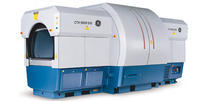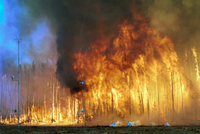-
Pentagon shifts $1 billion from WMD-defense efforts to vaccine development

The Obama administration has shifted more than $1 billion out of its nuclear, biological, and chemical defense programs to underwrite a new White House priority on vaccine development and production to combat disease pandemics; Defense Department projects under the budget-cutting ax include the development and acquisition of biological and chemical detection systems; gear to decontaminate skin and equipment after exposure; systems to coordinate military operations in a chem-bio environment; and protective clothing for military personnel entering toxic areas, the document indicates
-
-
Rapiscan in $12 million nuclear detection contract
DHS’s Domestic Nuclear Detection Office (DNDO) has contracted Rapiscan Systems for detection of shielded nuclear materials; the company has been tasked with developing a Liquefied Noble gas detector — in collaboration with Yale University — a threshold activation detector, a human portable system, and an aircraft inspection solution
-
-
Drive-by full-body scanning
Massachusetts-based American Science & Engineering is selling van-mounted backscatter X-ray detection system to law enforcement; these vans can be driven past neighboring vehicles to see their contents
-
-
New smell sensor uses genetically engineered frog eggs
Researchers use genetically engineered frog cells to develop a sensor that detects gasses; the researchers embedded the sensor into a mannequin, so that it could shake its head when a gas was detected, making it easier to observe
-
-
Skeletal scans could be newest screening technique
The adult skeleton has 206 bones; size, shape, density, and joint structure make each skeleton slightly different; throw in an extra lumbar vertebrae or extra rib — which some people have — as well as previously broken bones, implants, screws, and other identifying characteristics, and the signatures become even more individual
-
-
Flir to acquire sensor maker ICx for $274 million
Flir, maker of thermal imaging technology, is acquiring ICx for $274 million; the merger will give Flir the capability to expand into the market for advanced sensors for chemical, biological, radiological, and nuclear explosives (CBRN) detection for homeland security and defense
-
-
Detecting fertilizer-based IEDs
Since 2008, IEDs have accounted for more than half of all fatalities incurred by NATO forces in Afghanistan; last year, 275 NATO soldiers died in IED attacks, and that number will likely be surpassed this year; already 228 NATO soldiers have died due to homemade bombs this year; the U.S. military continues to search for IED countermeasures
-
-
3D, interactive X-ray to offer dramatic improvement in security scans
The latest X-ray scanners can glean information about the atomic or molecular weight of a substance, and so help distinguish between materials, but the results are crude; the best they can manage is to show metal objects in one color, organic materials in another, and everything else in a third color; a new technique — called kinetic depth effect X-ray imaging, or KDEX — builds up a 3D image of the object which can be rotated and viewed from a wide range of angles
-
-
Evidence shows Turkish use of chemical weapons against Kurdish fighters
German medical experts have confirmed the authenticity of photographs showing eight dead Kurdish PKK fighters — and that the photos prove that they were killed by “chemical substances”; Turkey has been suspected for a while now of using chemical weapons against Kurdish militants, and German politicians across the political spectrum, as well as human rights organizations, have called on Turkey to explain the findings; Turkey denies the charges, calling them “PKK propaganda”
-
-
New baggage screening system from Morpho Detection evaluated

Unlike most baggage-screening systems that create two-dimensional images of objects inside luggage, the CTX 9800 DSi scanners from Morpho Detection create three-dimensional images that can be digitally manipulated by personnel when a bag is deemed to be suspicious; the machines also use advanced software to detect suspicious items; Mineta San Jose International Airport once used 28 machines to process 1,800 bags an hour, but the new system will be able to process the same number of bags using eight machines and require fewer employees to supervise the process; the technology reduces reliance on human observation and interaction with the bags; for the majority of bags, employee contact is only required when a piece of luggage is placed on or taken off the conveyor belt
-
-
100 percent air-cargo screening is going smoothly -- so far
On 1 August a law mandating 100 percent screening of cargo transported on passenger aircraft took effect; the shipping industry says that, so far, are off to a good start; experts point out that August is relatively slow shipping month, and that the real test will come in mid-September, when the busy air cargo shipping season begins
-
-
U Rochester lands $15 million to study medical response to nuclear terrorism
Research has revealed that it is not just the immediate effect of radiation that makes adults and children sick; rather, the radiation damage can remain relatively undetected in key tissues and organs, but will trigger life-threatening illnesses after an injury that occurs later; new project places the University of Rochester Medical Center firmly in a leadership position in the counterterrorism effort
-
-
Wild fires in Russia may shower region with Chernobyl-era radioactive particles

Large forested areas in Bryansk were contaminated when the Chernobyl nuclear power plant’s Reactor No. 4 exploded during a pre-dawn test on 26 April 1986, spewing radioactive clouds over much of the western Soviet Union and northern Europe; radioactive particles settled into the soil, and environmentalists have warned that they could be thrown up into the air once again by wildfires and blown into other areas by the wind; the death rate in Moscow has doubled to 700 people a day
-
-
DHS seeking unattended sensors technology for border surveillance
DHS is seeking information from companies who can build unattended ground sensors that can detect and locate people, boats, or vehicles moving along rivers, roads, and paths in dense forests; DHS says it needs this capability for border surveillance to monitor those entering the United States illegally in rough terrain
-
-
India equipped to protect the October Commonwealth Games against WMD attacks
India will have a big security challenge when the Commonwealth Games begin in October; Indian security agencies say they are equipped to face chemical, biological, radiological, and nuclear (CBRN) terrorist threats during the games; intelligence agencies have been working on the possibility of attacks from Kashmiri groups like the Hizbul Mujahidden, the Pakistan-based Lashkar-e-Taiba (LeT), the Taliban from Pakistan or Afghanistan, and even Al Qaeda; militant outfits of various other ideological hues are also on the police radar
-
More headlines
The long view
Keeping the Lights on with Nuclear Waste: Radiochemistry Transforms Nuclear Waste into Strategic Materials
How UNLV radiochemistry is pioneering the future of energy in the Southwest by salvaging strategic materials from nuclear dumps –and making it safe.
Model Predicts Long-Term Effects of Nuclear Waste on Underground Disposal Systems
The simulations matched results from an underground lab experiment in Switzerland, suggesting modeling could be used to validate the safety of nuclear disposal sites.
